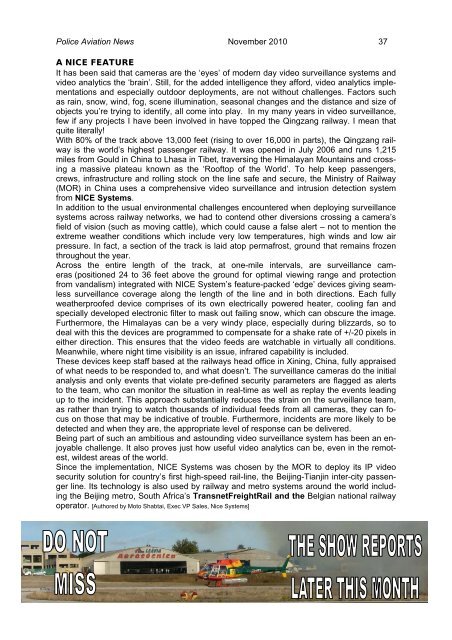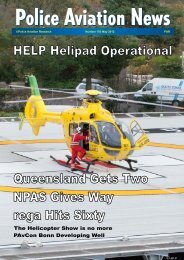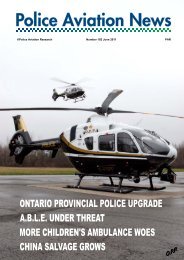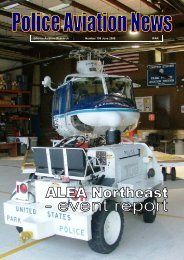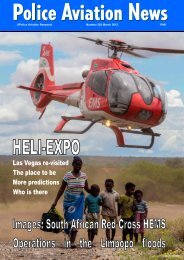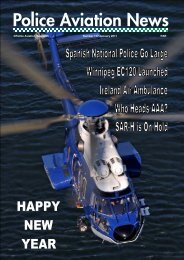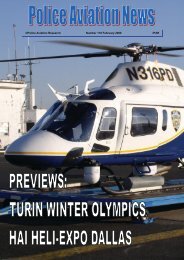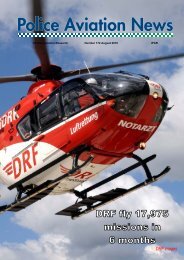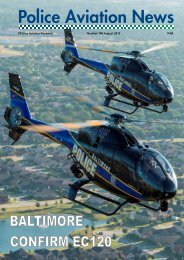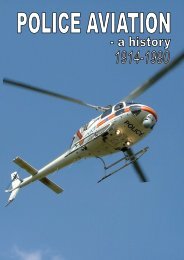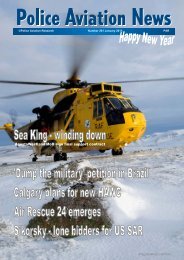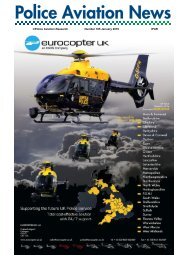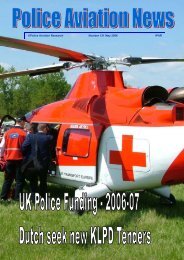Police Aviation News November 2010
Police Aviation News November 2010
Police Aviation News November 2010
You also want an ePaper? Increase the reach of your titles
YUMPU automatically turns print PDFs into web optimized ePapers that Google loves.
<strong>Police</strong> <strong>Aviation</strong> <strong>News</strong> <strong>November</strong> <strong>2010</strong> 37<br />
A NICE FEATURE<br />
It has been said that cameras are the ‘eyes’ of modern day video surveillance systems and<br />
video analytics the ‘brain’. Still, for the added intelligence they afford, video analytics implementations<br />
and especially outdoor deployments, are not without challenges. Factors such<br />
as rain, snow, wind, fog, scene illumination, seasonal changes and the distance and size of<br />
objects you’re trying to identify, all come into play. In my many years in video surveillance,<br />
few if any projects I have been involved in have topped the Qingzang railway. I mean that<br />
quite literally!<br />
With 80% of the track above 13,000 feet (rising to over 16,000 in parts), the Qingzang railway<br />
is the world’s highest passenger railway. It was opened in July 2006 and runs 1,215<br />
miles from Gould in China to Lhasa in Tibet, traversing the Himalayan Mountains and crossing<br />
a massive plateau known as the ‘Rooftop of the World’. To help keep passengers,<br />
crews, infrastructure and rolling stock on the line safe and secure, the Ministry of Railway<br />
(MOR) in China uses a comprehensive video surveillance and intrusion detection system<br />
from NICE Systems.<br />
In addition to the usual environmental challenges encountered when deploying surveillance<br />
systems across railway networks, we had to contend other diversions crossing a camera’s<br />
field of vision (such as moving cattle), which could cause a false alert – not to mention the<br />
extreme weather conditions which include very low temperatures, high winds and low air<br />
pressure. In fact, a section of the track is laid atop permafrost, ground that remains frozen<br />
throughout the year.<br />
Across the entire length of the track, at one-mile intervals, are surveillance cameras<br />
(positioned 24 to 36 feet above the ground for optimal viewing range and protection<br />
from vandalism) integrated with NICE System’s feature-packed ‘edge’ devices giving seamless<br />
surveillance coverage along the length of the line and in both directions. Each fully<br />
weatherproofed device comprises of its own electrically powered heater, cooling fan and<br />
specially developed electronic filter to mask out failing snow, which can obscure the image.<br />
Furthermore, the Himalayas can be a very windy place, especially during blizzards, so to<br />
deal with this the devices are programmed to compensate for a shake rate of +/-20 pixels in<br />
either direction. This ensures that the video feeds are watchable in virtually all conditions.<br />
Meanwhile, where night time visibility is an issue, infrared capability is included.<br />
These devices keep staff based at the railways head office in Xining, China, fully appraised<br />
of what needs to be responded to, and what doesn’t. The surveillance cameras do the initial<br />
analysis and only events that violate pre-defined security parameters are flagged as alerts<br />
to the team, who can monitor the situation in real-time as well as replay the events leading<br />
up to the incident. This approach substantially reduces the strain on the surveillance team,<br />
as rather than trying to watch thousands of individual feeds from all cameras, they can focus<br />
on those that may be indicative of trouble. Furthermore, incidents are more likely to be<br />
detected and when they are, the appropriate level of response can be delivered.<br />
Being part of such an ambitious and astounding video surveillance system has been an enjoyable<br />
challenge. It also proves just how useful video analytics can be, even in the remotest,<br />
wildest areas of the world.<br />
Since the implementation, NICE Systems was chosen by the MOR to deploy its IP video<br />
security solution for country’s first high-speed rail-line, the Beijing-Tianjin inter-city passenger<br />
line. Its technology is also used by railway and metro systems around the world including<br />
the Beijing metro, South Africa’s TransnetFreightRail and the Belgian national railway<br />
operator. [Authored by Moto Shabtai, Exec VP Sales, Nice Systems]


